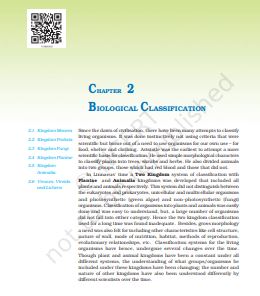‘NCERT Solutions for Class 11 Biology Chapter 2‘ PDF Quick download link is given at the bottom of this article. You can see the PDF demo, size of the PDF, page numbers, and direct download Free PDF of ‘Ncert Class 11 Biology Chapter 2 Exercise Solution’ using the download button.
NCERT Class 11 Biology Textbook Chapter 2 With Answer PDF Free Download

Chapter 2: Biological Classification
In Linnaeus’ time, a Two Kingdom system of classification with Plantae and Animalia kingdoms was developed that included all plants and animals respectively.
This system did not distinguish between the eukaryotes and prokaryotes, unicellular and multicellular organisms, and photosynthetic (green algae) and non-photosynthetic (fungi) organisms.
Classification of organisms into plants and animals was easily done and was easy to understand, but, a large number of organisms did not fall into either category.
Hence the two kingdom classification used for a long time was found inadequate.
Besides, gross morphology a need was also felt for including other characteristics like cell structure, nature of the wall, mode of nutrition, habitat, methods of reproduction, evolutionary relationships, etc.
Classification systems for living organisms have hence, undergone several changes over time.
Though plant and animal kingdoms have been a constant under all different systems, the understanding of what groups/organisms be included under these kingdoms has been changing; the number and nature of other kingdoms have also been understood differently by
different scientists over time.
R.H. Whittaker (1969) proposed a Five Kingdom Classification. The kingdoms defined by him were named Monera, Protista, Fungi, Plantae, and Animalia.
The main criteria for classification used by him include cell structure, body organization, mode of nutrition, reproduction, and phylogenetic relationships.
Table 2.1 gives a comparative account of the different characteristics of the five kingdoms.
The three-domain system has also been proposed that divides the Kingdom Monera into two domains, leaving the remaining eukaryotic kingdoms in the third domain and thereby a six kingdom classification. You will learn about this system in detail in higher classes.
Let us look at this five-kingdom classification to understand the issues and considerations that influenced the classification system.
Earlier classification systems included bacteria, blue-green algae, fungi, mosses, ferns, gymnosperms, and the angiosperms under ‘Plants’.
The character that unified this whole kingdom was that all the organisms included had a cell wall in their cells.
This placed together groups that widely differed in other characteristics. It brought together the prokaryotic bacteria and the blue-green algae (cyanobacteria) with other groups which were eukaryotic.
It is also grouped together with the unicellular organisms and the multicellular ones say, for example, Chlamydomonas and Spirogyra were placed together under algae.
| Author | NCERT |
| Language | English |
| No. of Pages | 13 |
| PDF Size | 2.9 MB |
| Category | Biology |
| Source/Credits | ncert.nic.in |
NCERT Solutions Class 11 Biology Chapter 2 Biological Classification
1. Discuss how classification systems have undergone several changes over a period of time.
Solution:
Aristotle was the first to introduce the scientific classification. He used simple morphological characters to classify plants into trees, shrubs, and herbs. He divided the animals into two groups, one with red blood and one without.
Linnaeus introduced a two-kingdom classification, which includes Plantae and Animalia, respectively, of plants and animals.
But this classification does not classify eukaryotes and prokaryotes, single-celled and multicellular organisms, photosynthetic (green algae), and non-photosynthetic (fungal) organisms.
Therefore, the system was found to be less significant as it did not include more features.
Thus, the classification of living organisms has undergone several changes. R.H. Whittaker introduced five-kingdom classification, including Monera, Protista, Fungi, Plantae, and Animalia.
Some of the characteristics included in this classification – are the structure of cells, body organization, mode of nutrition, mode of reproduction, and phylogenetic relationship to classify organisms.
Subsequently, a three-domain system was proposed, which divided Kingdom Monera into two domains, leaving the remaining eukaryotic kingdoms in the third domain, thereby classifying the six kingdoms.
2. State two economically important uses of:
(a) heterotrophic bacteria
(b) archaebacteria
Solution:
a) Heterotrophic bacteria are used in the production of vitamins, antibiotics, cheese and curd.
They help fix nitrogen and are used in the formation of humus.
b) Archaebacteria are used in Biogas production.
They are used in the bioleaching of mines.
3. What is the nature of cell walls in diatoms?
Solution:
In diatoms, cell walls are embedded with silica imparting characteristic patterns onto the walls and are indestructible.
These diatoms leave large amounts of cell wall deposits in their habitat to accumulate to form the diatomaceous earth.
4. Find out what the terms ‘algal bloom’ and ‘red-tides’ signify.
Solution:
Algal blooms are found in contaminated water. They are an overgrowth of algae, especially blue-green algae (cyanobacteria). Their growth leads to water pollution. They inhale carbon dioxide and exhale oxygen.
Rapid multiplication of red-pigmented dinoflagellates, such as Gonaulax, gives the sea a red color, a phenomenon known as red tides. These algae produce toxins that kill fish and other aquatic organisms.
Biological Classification NCERT Textbook With Solutions PDF Free Download
